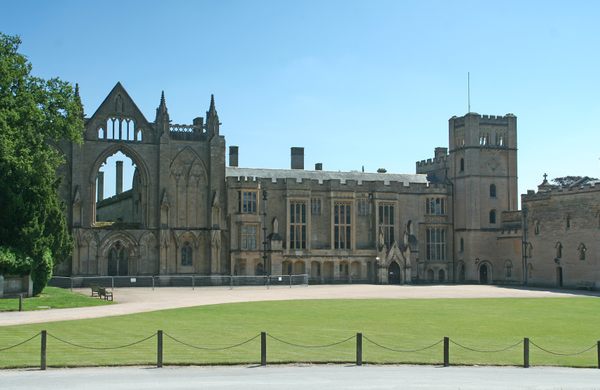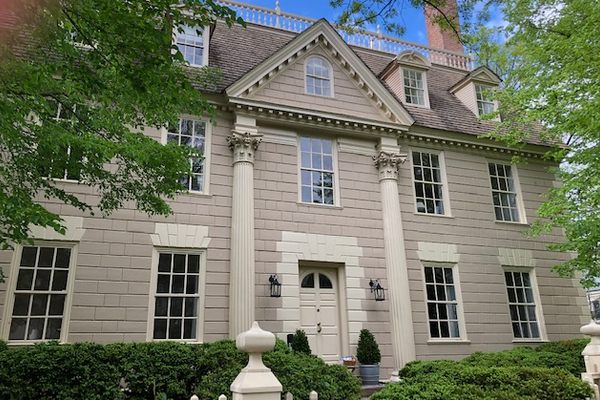Newstead Abbey
The ancestral home of beloved English poet Lord Byron has a bizarre history.
Best known as the ancestral home of 19th-century romantic poet Lord Byron, Newstead Abbey in Nottinghamshire, England hosts ghosts, sunken treasure, the touching tomb of a faithful dog, a waterfall you can go behind, and a mini fortress built for shooting at peasants in mock naval battles.
The estate has a long and often bizarre history, and is full of hidden gems. Originally built by Augustinian monks in 1170, much of the original ecclesiastical building was destroyed on the orders of Henry VIII in 1539. Determined that the king’s men would not get ahold of the abbey’s treasures, the monks threw them into the lake in front of the abbey. The only piece since recovered is a stunning brass lectern in the shape of an eagle, which was rediscovered in the 18th century and is now on display in Southwell Minster, which is fewer than 15 miles from Newstead Abbey. It’s possible that more of the monks’ treasures still exist, sunken in the mud beneath the lake.
According to legend, one of the monks never left the estate. A spectral hooded figure, called either the Black or Goblin Friar, is said to be a harbinger of bad news and has been allegedly sighted many times in the abbey and surrounding grounds.
After the dissolution of the monasteries, the abbey fell into the hands of the Byron family in 1540 and eight generations of Byrons restored and added to the building, turning it into a beautiful and grand country house with landscaped gardens. Much of the current house dates to the 16th century.
The poet Byron was famously described as being “mad, bad and dangerous to know.” However, he wasn’t the only family member to exhibit such traits. His great uncle, the 5th Lord William “the Wicked” Byron, had quite a good line in madness, badness, and danger too. He killed his neighbor from nearby Annesley Hall in a duel after an argument over whose Nottinghamshire estate had the best hunting. Though convicted of manslaughter, his punishment was merely a fine. He later mounted the sword he used in the duel in his bedroom.
In his twilight years, William had two follies constructed on one of the lakes to enable him to relive past glories by staging mock naval battles at the abbey for his own amusement. During these mock battles, he would happily shoot at servants in rowing boats with live ammunition from the safety of his pretend forts. One of the forts is now in a crumbling state of disrepair whereas another has become part of a private house. After his son began an incestuous marriage with a cousin, William “the Wicked” Byron was determined to ruin the estate so his son would have nothing to inherit.
The poet Byron was the last Lord Byron to own Newstead Abbey. He inherited it in a very dilapidated state at the age of just 10 following the death of his great uncle William, whose son and grandson died before him. The poet found the ruinous house inspirational, writing, “Thro’ thy battlements, Newstead, the hollow winds whistle; Thou, the hall of my fathers, art gone to decay.”
Despite once claiming that “Newstead and I stand or fall together” he was sadly forced to sell the abbey in 1818 due to his dire financial situation. He died six years later of a fever in Greece at age 36 and is buried with his equally talented daughter, Ada Lovelace—the world’s first computer programmer—at the Church of Saint Mary Magdalene in nearby Hucknall.
One of the most poignant reminders of the poet Byron’s time at Newstead Abbey is the tomb of his faithful Newfoundland dog, Boatswain, which stands proudly in the landscaped garden bearing a touching poem called “Epitaph to a Dog.” Byron reportedly wished to be buried alongside his beloved dog after his death, though this wish was never fulfilled.
Sophia Hyatt, a kind of 19th-century super-fan of the poet, took up lodgings near Newstead shortly after his untimely death. Hyatt would wander around the abbey grounds following in the poet’s footsteps, wearing white and writing her own poems about her celebrity idol. One day after leaving Newstead, she was struck and killed by a coach and horses in Nottingham Market Square, and her lonely spirit, The White Lady of Newstead, is supposedly still seen wandering around the abbey grounds today.
The Abbey and Gardens are currently owned by Nottingham City Council, who also administer nearby Nottingham Castle and Wollaton Hall. All three houses are open to the public. The River Leen flows out of the ground’s lake and cascades over a manmade waterfall with a small grotto behind it. The grotto can be accessed via a dark passageway, giving an unusual view toward the abbey through the tumbling waters.
Know Before You Go
The main entrance to the Abbey Grounds is in the village of Ravenshead, between Mansfield and Nottingham opposite the 13th Century Public House, The Hutt. There is an alternative entrance for walkers and cyclists only, which is not well signposted, from Newstead Village which is reached by following Station Avenue until you reach the gatehouse. Trains run to Newstead Village from Nottingham, Mansfield and Worksop on the Robin Hood Line. The abbey can be reached by bus from Nottingham Victoria or Mansfield Bus stations, using the Pronto Service. Although it's a great place for a picnic, Newstead Abbey does have a cafeteria selling tea, coffee, cakes, and sandwiches.

























Follow us on Twitter to get the latest on the world's hidden wonders.
Like us on Facebook to get the latest on the world's hidden wonders.
Follow us on Twitter Like us on Facebook